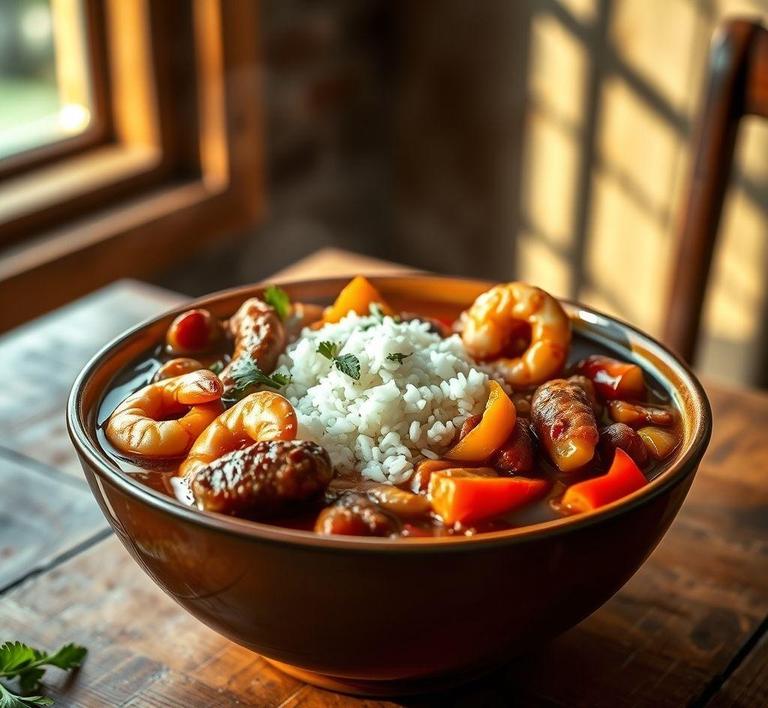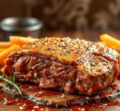If you’ve ever made a big batch of gumbo and found yourself with leftovers, you might be wondering whether it’s safe to refreeze it. The process of refreezing gumbo can be a bit tricky, but with the right approach, you can enjoy your flavorful dish again without sacrificing its taste or texture. In this guide, we’ll walk you through everything you need to know about refreezing gumbo, from how to store it properly to the best methods for reheating, so that your next gumbo meal is just as satisfying as the first!
Can You Refreeze Gumbo?

Gumbo is a rich, hearty dish that originates from Louisiana, with a blend of savory flavors, often combining meats like sausage, shrimp, and chicken, along with a mixture of vegetables like bell peppers, onions, and celery. It’s traditionally served over rice and is known for its thick, stew-like consistency. Because of its complexity and the wide array of ingredients involved, gumbo is a dish that can be made in large batches and saved for later.
But what happens when you find yourself with leftovers or have cooked a big pot of gumbo and want to save it for a rainy day? You may wonder if it’s safe or advisable to refreeze gumbo. The short answer is yes, it’s possible to refreeze gumbo, but with important considerations to ensure both food safety and the retention of the dish’s quality. Freezing gumbo initially can be a great way to preserve it, but there are specific rules and steps to follow if you want to freeze it again after it’s been thawed.
How To Refreeze Gumbo?
The process of refreezing gumbo begins with understanding a few key factors: the time it’s been sitting out, the temperature it’s been kept at, and the way it was initially frozen. Here’s a step-by-step guide to ensure you can safely and effectively refreeze gumbo:
- Cool it Down Quickly: After cooking, you should allow your gumbo to cool to room temperature, but don’t leave it out for more than two hours. The bacteria that cause foodborne illnesses multiply quickly at room temperature, so prompt cooling is essential. You can speed up the cooling process by dividing the gumbo into smaller portions or placing the pot in an ice bath.
- Store it Properly the First Time: The best way to freeze gumbo initially is by placing it in an airtight container or heavy-duty freezer bag. Squeeze out excess air from the bag to avoid freezer burn, which can affect the texture and flavor. Be sure to label the container with the date so you know how long it’s been frozen.
- Thawing Gumbo: When you thaw gumbo, it’s essential to do so safely. The best way is to place it in the refrigerator for several hours or overnight, allowing it to thaw gradually. Avoid thawing gumbo at room temperature, as this can encourage bacterial growth. You can also use the stovetop to reheat it gently.
- Refreezing: Once your gumbo is fully thawed, you can refreeze it, but make sure it hasn’t been left out at room temperature for extended periods. Refreezing gumbo that’s been kept too warm during the thawing process can lead to unsafe food handling practices. If the gumbo has been reheated and cooled within a safe time frame, it can be refrozen. However, it’s important to note that each time you thaw and refreeze food, it slightly degrades in quality, so it should be consumed quickly after the second freeze.
- Portioning: To make the process easier, consider dividing your gumbo into smaller portions before freezing it the first time. This way, you can thaw and refreeze only what you need, instead of repeatedly freezing and thawing the entire batch.
Quality Impact
While refreezing gumbo is entirely possible, it’s essential to understand that doing so can have a significant impact on its quality. Here are a few things to keep in mind:
- Texture Changes: Gumbo contains a variety of ingredients, such as meats, seafood, and vegetables, that all have different textures. Freezing and thawing cause the water content in these ingredients to form ice crystals. When the gumbo is thawed, these ice crystals can cause the vegetables to become mushy, and the meat or seafood to lose its firm texture. The okra in gumbo, which is often used as a thickener, can break down and become slimy after being frozen and refrozen.
- Flavor Deterioration: The process of freezing and refreezing can also cause slight changes in the flavor of gumbo. The spices, herbs, and seasonings may become less vibrant or lose their potency after being frozen multiple times. The gumbo could taste more muted or even develop an off-flavor if not stored and handled properly. If the gumbo has seafood or sausage, these components might become less fresh or aromatic upon refreezing.
- Separation of Broth: The broth in gumbo, which is usually made with a roux (a flour and fat mixture) or other thickening agents, might separate after freezing and refreezing. This can make the gumbo appear watery or less cohesive once reheated. The roux might also break down and cause a less smooth texture.
- Rice Quality: Gumbo is often served over rice, but rice doesn’t freeze and refreeze very well. If you freeze gumbo with rice already in it, the rice can become mushy when reheated. For the best results, store rice separately and add it to the gumbo after reheating.
Refreezing gumbo is possible, but it comes with its risks when it comes to quality. If you’re looking to preserve the dish for a later time, freezing it once is the best option, as repeated thawing and freezing can affect the texture and flavor. For the best results, follow the proper steps to cool, store, thaw, and reheat gumbo, keeping in mind that while it’s safe to refreeze under the right conditions, each cycle may slightly degrade its quality. If you’re a gumbo lover and find yourself with leftovers, it’s important to understand that refrozen gumbo may not be quite as perfect as when it was first made, but with proper care, it can still be an enjoyable meal. Just make sure to enjoy it soon after the second freeze to ensure it’s at its most flavorful and safe to eat.
Is It Safe To Refreeze Gumbo?
Refreezing gumbo, or any type of cooked dish, raises important safety concerns, especially when it comes to maintaining both flavor and quality. The general rule of thumb is that it can be safe to refreeze gumbo as long as it has been handled properly, but several factors must be taken into account to ensure it remains both safe and enjoyable.
Gumbo, a flavorful and hearty dish with a base of stock, vegetables, and often seafood or meat, can withstand some freezing and thawing, but its integrity depends heavily on how it was originally frozen and thawed. The most crucial factor is how long the gumbo has been sitting at room temperature and the number of times it has been frozen and thawed. The FDA advises that perishable foods, including gumbo, should not be left out at room temperature for more than two hours. If gumbo has been properly frozen and thawed at safe temperatures, and you haven’t exceeded the limit for how many times it’s been frozen and thawed, then yes, it is generally safe to refreeze.
However, keep in mind that while it’s safe from a food safety standpoint, refreezing may affect the texture and flavor of the gumbo, especially if it contains seafood or delicate vegetables. Repeated freezing and thawing can cause ice crystals to form, which disrupts the texture of both the broth and the ingredients. For example, seafood may become rubbery, and vegetables like okra or bell peppers might lose their crispness, resulting in a soggy and less appetizing dish upon reheating.
Signs That Gumbo Should Not Be Refrozen
Knowing when to toss out or simply not refreeze gumbo is equally important as knowing when it’s safe to do so. Here are a few red flags to watch out for:
-
Improper Thawing or Prolonged Room Temperature Exposure
If the gumbo was left out at room temperature for more than two hours, it should not be refrozen. Bacteria can multiply rapidly in warm environments, and the longer gumbo sits unrefrigerated, the higher the risk of foodborne illness. If it was left at room temperature for a prolonged period, even if it was later refrigerated, it’s best to avoid refreezing.
-
Foul Smell or Off Taste
Gumbo that has developed a sour, rancid, or spoiled odor is a clear indicator that it should not be refrozen. This might happen due to improper storage or an ingredient that went bad before it was frozen. Trust your nose and taste buds-if it doesn’t smell or taste right, don’t risk refreezing it.
-
Visible Signs of Freezer Burn
Freezer burn happens when food has been in the freezer for too long or is not stored in airtight containers. If you notice extensive freezer burn on the gumbo or on its surface ingredients (like the meat or seafood), it can degrade the texture and flavor. While it’s still safe to eat, the quality will be compromised, and refreezing won’t help the gumbo recover any of its original taste or consistency.
-
Discoloration or Separation of Ingredients
While gumbo is often a thick, hearty dish, it may separate slightly when thawed due to changes in the fat and liquid content. However, if the gumbo has a strange, inconsistent look, especially if the oil or fat has separated into a weird layer on top, it may be a sign that it’s been improperly frozen or thawed, making it unsafe or unappetizing to refreeze.
-
Excessive Thawing and Refreezing
If gumbo has already been thawed and refrozen more than once, it’s best not to do it again. Each cycle of freezing and thawing increases the risk of bacteria growth and degrades the quality of the dish. Ideally, gumbo should be thawed only once.
Common Refreezing Mistakes
When refreezing gumbo, it’s easy to make mistakes that can negatively impact both its safety and quality. Here are some common pitfalls to avoid:
-
Thawing at Room Temperature
One of the most dangerous mistakes is leaving gumbo to thaw on the counter at room temperature. Bacteria can multiply quickly in the temperature "danger zone" (40°F – 140°F). The best way to thaw gumbo safely is in the refrigerator, allowing it to defrost slowly at a safe, controlled temperature.
-
Refreezing After Multiple Thawing Cycles
As mentioned earlier, repeatedly thawing and refreezing gumbo can ruin its texture and flavor, while also making it unsafe to eat. If you’re unsure how many times the gumbo has been thawed, it’s safer to skip the refreezing process altogether.
-
Freezing Gumbo in Large Portions
Freezing gumbo in large portions or in a single bulky container can make it difficult to thaw evenly and safely. Instead, divide your gumbo into smaller, manageable portions. This way, you only need to thaw what you plan to eat, preventing the need to refreeze leftovers.
-
Not Storing in Airtight Containers
Gumbo should always be stored in airtight containers or freezer bags. Failure to do this increases the risk of freezer burn and improper freezing, which can lead to poor quality when it’s thawed and reheated. Be sure to expel as much air as possible from freezer bags to help preserve flavor and texture.
-
Ignoring Ingredient Sensitivity
Not all ingredients in gumbo freeze well. Seafood, especially shrimp or crab, can turn rubbery and mushy upon freezing and thawing, while vegetables like okra or bell peppers may become soft and mushy. If you plan to refreeze gumbo, consider removing delicate ingredients, or try making a fresh batch of those components after reheating the frozen gumbo.
Tips And Tricks
To make the most of refreezing gumbo and minimize the risk of compromising the dish, here are some useful tips:
-
Cool Gumbo Properly Before Freezing
Always allow gumbo to cool to room temperature before placing it in the freezer. Placing hot gumbo directly into the freezer can raise the temperature inside the appliance and affect the quality of other frozen food. For quicker cooling, place the gumbo in shallow containers or use an ice bath to help it cool down faster.
-
Use Freezer-Safe Containers
Invest in high-quality, airtight containers specifically designed for freezing. Glass containers or heavy-duty freezer bags are ideal, as they help retain the gumbo’s flavor and prevent freezer burn. Avoid using regular plastic containers or flimsy bags that could rupture or let air in.
-
Label and Date Your Gumbo
When freezing gumbo, always label your containers with the date of freezing. This will help you keep track of how long it’s been in the freezer, ensuring that you don’t keep it for too long. As a general rule, gumbo can last in the freezer for about 3-4 months, though the sooner you eat it, the better the taste and texture.
-
Thaw Slowly in the Fridge
If you plan to refreeze gumbo, always thaw it slowly in the refrigerator overnight. Fast-thawing methods like using a microwave can cause uneven temperature changes and negatively affect the texture of the dish.
-
Reheat Gently
When you’re ready to eat, reheat gumbo slowly on the stove or in the microwave, stirring occasionally. Avoid bringing it to a full boil, as this can overcook delicate ingredients like seafood and cause the gumbo to become too thick or congealed.
Conclusion
Refreezing gumbo is possible, but it comes with a set of challenges and precautions. While it can be safe to refreeze gumbo as long as it has been handled properly-kept at safe temperatures and not thawed or refrozen too many times-it’s important to keep in mind that the quality may degrade. Ingredients like seafood and vegetables may lose texture and flavor after freezing and thawing cycles. Additionally, proper storage, thawing, and reheating techniques are essential to ensure that your gumbo remains safe and as delicious as possible.
By following safe food practices, paying attention to the signs of spoilage, and making smart storage choices, you can enjoy the convenience of refreezing your gumbo without compromising your meal’s safety or taste. However, when in doubt, it’s always better to enjoy freshly made gumbo for the best experience.


